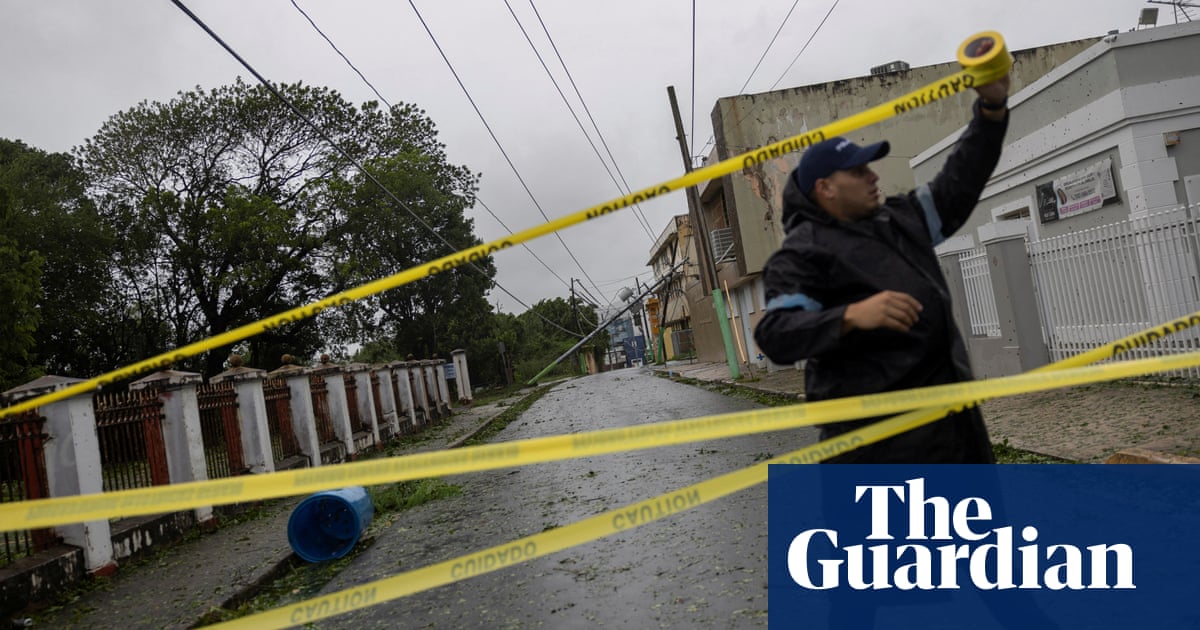
Storm Ernesto has strengthened into a hurricane as it dropped torrential rain on Puerto Rico and left nearly half of all clients in the US territory without power.
The storm was located about 175 miles (280km) north-west of San Juan, Puerto Rico and was moving over open waters towards Bermuda. It had maximum sustained winds of 75mph (120km/h) and was moving north-west at 16mph.
“The official forecast still reflects the possibility of Ernesto becoming a major hurricane in about 48 hours,” the National Hurricane Center said late on Wednesday morning.
A tropical storm warning was in effect for Puerto Rico and its outlying islands of Vieques and Culebra and for the US and British Virgin Islands.
“I know it was a long night listening to that wind howl,” said Albert Bryan Jr, governor of the US Virgin Islands, in a news conference.
An island-wide blackout was reported in St John and St Croix, and at least six cellphone towers were knocked offline across the US territory, said Daryl Jaschen, emergency management director.
He added that the airports in St Croix and St Thomas were expected to reopen at midday.
Schools and government agencies, however, remained closed in the US Virgin Islands and Puerto Rico, where heavy flooding was reported in several areas, forcing officials to block roads, some of which were strewn with trees. Nearly 100 flights also were canceled to and from Puerto Rico.
“A lot of rain, a lot of rain,” said Edilberto Romero, the Culebra mayor, in a phone interview. “We have trees that have fallen on public roads. There are some roofs that are blown off.”
Ernesto is forecast to move through open waters for the rest of the week and make its closest approach to Bermuda on Friday and Saturday. It is expected to become a major category 3 storm in the upcoming days and then weaken slightly to a category 2 as it nears Bermuda.
“Residents need to prepare now before conditions worsen,” said Bermuda’s national security minister, Michael Weeks. “Now is not the time for complacency.”
Forecasters also warned of heavy swells along the US east coast.
“That means that anybody who goes to the beach, even if the weather is beautiful and nice, it could be dangerous … with those rip currents,” said Robbie Berg, warning coordination meteorologist with the National Hurricane Center.
Between four to six inches of rain is expected in the US and British Virgin Islands and between six to eight inches in Puerto Rico, with up to 10 inches in isolated areas.
The government of the US Virgin Islands reported an island-wide blackout in St Croix, while in Puerto Rico, more than half a million customers were without power.
Late on Tuesday, the US Federal Emergency Management Agency had warned people in both US territories to prepare for “extended power outages”.
Luma Energy, the company that operates transmission and distribution of power in Puerto Rico, said early on Wednesday that its priority was to restore power to hospitals, the island’s water and sewer company and other essential services.
Puerto Rico’s power grid was razed by Hurricane Maria in September 2017 as a category 4 storm, and it remains frail as crews continue to rebuild the system.
Not everyone can afford generators on the island of 3.2 million people with a more than 40% poverty rate.
“People already prepared themselves with candles,” said Lucía Rodríguez, a 31-year-old street vendor.
Pedro Pierluisi, Puerto Rico’s governor, announced late on Tuesday that Joe Biden had approved his request to use emergency Fema funds as a result of the tropical storm.
Ernesto is the fifth named storm of this year’s Atlantic hurricane season.
The National Oceanic and Atmospheric Administration has predicted an above-average Atlantic hurricane season this year because of record warm ocean temperatures. It forecast 17 to 25 named storms, with four to seven major hurricanes of category 3 or higher.
Source: theguardian.com


















